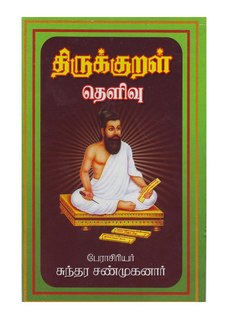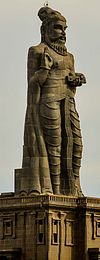
The Tirukkural, or shortly the Kural, is a classic Tamil text consisting of 1,330 couplets or Kurals, dealing with the everyday virtues of an individual. It is one of the two oldest works now extant in Tamil literature in their entirety, the other being the Tolkappiyam. Considered one of the greatest works ever written on ethics and morality, chiefly secular ethics, it is known for its universality and non-denominational nature. It was authored by Valluvar, also known in full as Thiruvalluvar. The text has been dated variously from 300 BCE to 5th century CE. The traditional accounts describe it as the last work of the third Sangam, but linguistic analysis suggests a later date of 450 to 500 CE.
William Henry Drew was a Christian missionary to India who rendered the Tirukkural into English. However, he translated only the first 630 couplets (kurals).
John Lazarus (1845–1925) was a Christian missionary to India who rendered the Tirukkural into English. He revised the work of his predecessor William Henry Drew, who had already translated the first 63 chapters of the Tirukkural, and translated the remaining portion of the Kural text.
Tirukkural remains one of the most widely translated non-religious works in the world. As of 2014, there were at least 57 versions available in the English language alone. English, thus, continues to remain the language with most number of translations available of the Kural text.
As of 2015, Latin is the first foreign language into which the Tirukkural was translated. There are three known translations of the Kural text available in Latin.
Hindi perhaps has the second most translations of the Tirukkural among all the languages in India, next only to Malayalam. There are at least 19 translations of the Kural text available in Hindi. Many of these translations are in verse form.
Kannada has at least eight translations of the Tirukkural available as of 2014. Both prose and verse translations have been made in Kannada.
Malayalam has seen the most number of Tirukkural translations than that of any other language in India. As of 2007, there are at least 21 translations of the Kural text available in Malayalam. Malayalam also has the distinction of producing the first ever translation of the Kural text among the languages in India and the world at large. The Annual Report of the Cochin Archeological Department for the year 1933–34 reported an unpublished manuscript of a Malayalam translation of the Tirukkural made in 1595.
Telugu is one of the Indian languages that has had the earliest Tirukkural translations in modern times. As of 2000, there are at least 14 translations of the Kural text available in Telugu.
Herbert Arthur Popley was a Christian missionary of London Mission, Erode, known for his literary work as a translator of the Tirukkural and his skill in rendering Tamil Christian music in the Carnatic style. He was secretary of the All-India Y.M.C.A. At the time of his death, he was president of the local Y.M.C.A. and a director of the Coonoor Co-operative Urban Bank Ltd. He died in Coonoor on 9 May 1960 at the age of 81.
Manakkudavar was a Tamil poet and commentator known for his commentary on the Thirukkural. His is the earliest of the available commentaries on the ancient work, and hence considered to bear closest semblance with the original work by Valluvar. He was among the canon of ten medieval commentators of the Kural text most highly esteemed by scholars. He was also among the five ancient commentators whose works had been preserved and made available to the Modern era, the others being Pari Perumal, Kaalingar, Paridhi, and Parimelalhagar.
S. M. Michael was one of the early 20th-century translators of the Tirukkural into English.
P. S. Sundaram (1910–1998) was an Indian professor of English, best known for translating the Tirukkural and various Tamil classics into English. He had degrees in English from the University of Madras and the Oxford University. He served as professor of English for about 40 years in different parts of North India.
Tiruvalluva Maalai, literally 'Garland of Valluvar', is an anthology of ancient Tamil paeans containing fifty-five verses each written by different poets praising the ancient work of the Kural and its author Valluvar. With the poets' time spanning across centuries starting from around 1st century CE, the collection is believed to have reached its present form by 11th century CE. With the historical details of the ancient philosopher and his work remaining obscure, much of the legend on the Kural and Valluvar as they are known today are chiefly from this work. The collection also reveals the name of the author of the Kural text as 'Valluvar' for the first time, as Valluvar himself composed the Kural text centuries earlier without indicating his name anywhere in his work. Reminiscing this, Monsieur Ariel, a French scholar of the 19th century, famously said of the Tirukkural thus: Ce livre sans nom, par un autre sans nom.
Tirukkural, or the Kural, an ancient Indian treatise on common moralities, has been given by various names ever since its writing around the first century BCE. Originally referred to as Muppāl, perhaps as presented by its author Valluvar at the ruler's court, the work remains unique among ancient works in the sense that it was not given any title by its author himself. All the names that the work is referred by today are given by later days' scholars over the millennia. The work is known by an estimated 44 names excluding variants, although some scholars list even more. Monsieur Ariel, a French scholar of the 19th century who translated the work into French, famously said of the Kural thus: Ce livre sans nom, par un autre sans nom.
Tarlochan Singh Bedi is an academician better known for translating the Kural into Punjabi.
The Book of Inbam, in full Iṉbattuppāl, or in a more sanskritized term Kāmattuppāl, also known as the Book of Love, the Third Book or Book Three in translated versions, is the third of the three books or parts of the Kural literature, authored by the ancient Indian philosopher Valluvar. Written in High Tamil distich form, it has 25 chapters each containing 10 kurals or couplets, making a total of 250 couplets all dealing with human love. The term inbam or kamam, which means 'pleasure', correlates with the third of the four ancient Indian values of dharma, artha, kama and moksha. However, unlike Kamasutra, which deals with different methods of lovemaking, the Book of Inbam expounds the virtues and emotions involved in conjugal love between a man and a woman, or virtues of an individual within the walls of intimacy, keeping aṟam or dharma as the base.
The dating of the Tirukkural, and by extension the period of its author Valluvar, has been a subject of intense debate among scholars for centuries, and it continues to remain so. The Tamil Nadu government has ratified 31 BCE as the year of birth of Valluvar. Still the precise date as to when Valluvar completed writing the Kural text remains murky. This article speaks about various dates arrived at by various scholars over time.



